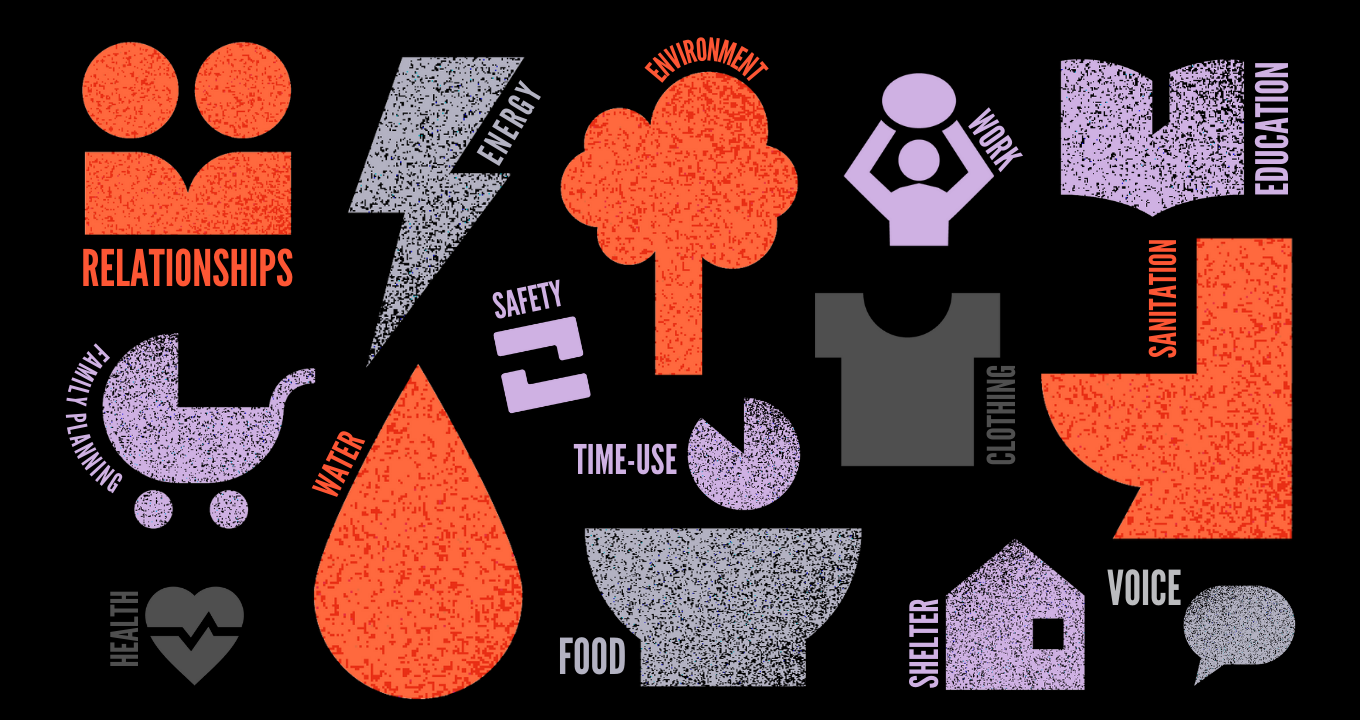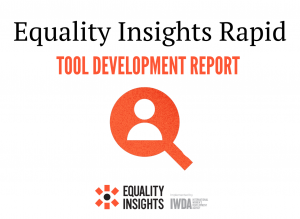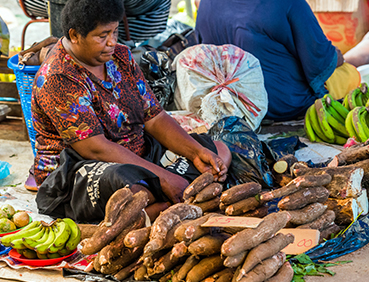Click on the arrows below to expand the Dimensions.
| Adequate clothing is a human right, and an important dimension of multidimensional poverty as clothing influences a person’s physical appearance and social circumstances. Lack of protective clothing can lead to unhealthy sun, wind, or cold exposure and lack of appropriate footwear can lead to injury. Clothing and footwear can also reveal someone’s social status and lack of adequate clothing can be a marker of poverty. In many contexts, these social expectations are highly gendered, and often more complex for women and girls. |
|
The Clothing dimension in the Equality Insights Rapid survey asks respondents questions related to three main areas: 1) ownership of sufficient clothing/ footwear, 2) extent to which available clothing/ footwear provides protection from the weather, and 3) social appropriateness of the clothing and footwear available. |
| Education is an important dimension of multidimensional poverty because low levels of education can hinder economic prosperity. Globally, quality education is key to escaping poverty. However, poverty itself is a major barrier to education. |
|
The Education dimension in the Equality Insights Rapid survey measures two themes: 1) education level, and 2) functional literacy. |
| Education level measures the highest level of education completed.
Functional literacy measures a respondent’s self-reported ability to read texts they encounter in regular life such as newspapers, government forms, or instructions. |
| Energy is measured as a dimension of poverty because unaffordable and unclean energy can have adverse consequences for individuals and communities. Globally, poorer households are more likely to use unclean energy sources such as wood and wood chips which require fuel collection and can result in harmful fumes when burned, especially when ventilation is poor. Gender roles within a household relating to cooking and fuel collection may mean household members are exposed to different levels of harm. Insufficient energy for lighting can have implications for education and home-based work. |
|
The Energy dimension of the Equality Insights Rapid survey measures two areas: 1) quality of fuel sources and, 2) sufficiency of energy supply to meet lighting and cooking needs. |
|
Quality of fuel sources focuses on measuring exposure to unclean fuel sources and is measured both at the household and individual level by triangulating responses to the source of cooking fuel (clean versus unclean), location of cooking (separate room versus shared space), ventilation (whether cooking devices include a fan or chimney), and frequency of performing cooking duties.
Sufficiency of energy supply is measured at an individual level to understand energy deprivation within households.
|
| Environment is measured as part of multidimensional poverty because it can impact an individual’s safe access to, and utilisation of, various resources including transportation, schooling, and employment. Environmental shocks (such as natural hazards including cyclones and droughts) and pollution (such as land, water, air, and soil pollution) can impact safety and health. Those living in poverty are more likely to experience environmental harms, such as pollution or climate change. |
|
The Environment dimension of the Equality Insights Rapid survey measures respondents’ exposure to natural hazards and pollution in the last 12 months. These include both household-level exposure to natural hazards and pollution as well as severity of exposure for individuals based on their daily activities |
| Reproductive health and rights, including family planning are crucial to achieving gender equality and women’s empowerment. They are also a critical factor in reducing poverty. The ability to control fertility influences women’s economic circumstances through education and employment opportunities. These outcomes can in turn lead to improvements in their economic security and the overall wellbeing of their households. Yet, globally in 2021, estimates indicated that 164 million women worldwide had an unmet need for family planning (i.e., wanting to avoid or postpone pregnancy but not using any form of contraception). |
|
The family planning dimension in the Equality Insights Rapid survey focuses on only one area of measurement – the unmet need for contraception.
The survey includes seven questions related to current need for contraception, and if there is a current need, the type of contraception method used. Participants aged 60 and above, as well as respondents who have indicated that they or their partner are currently pregnant, are excluded from questions related to contraception. |
| Food security is a core dimension of living a life free of poverty and an important aspect of multidimensional poverty. The United Nations Food and Agriculture Organisation (FAO) describes food security through four key elements: availability, access, utilisation, and stability. Due to the nature of the survey tools and the context of its use, Equality Insights Rapid uses food access as the sole indicator of food insecurity, assessed by the Food Insecurity Experience Scale (FIES). |
|
The Food dimension of the Equality Insights Rapid survey measures severity of food insecurity, using the eight questions that make up the FIES. These questions focus on whether, in the last twelve months, a person has worried about a lack of food, lacked nutritious food, lacked a variety of food, had to skip a meal, ate less, went hungry or ran out of food. Scoring is based on FAO’s global thresholds. |
| The World Health Organisation defines health as “[a] state of complete physical, mental and social well-being and not merely the absence of disease or infirmity”. Health is an important component of multidimensional poverty because globally, people living in poverty are more likely to suffer worse health outcomes and die younger than more affluent populations. |
|
The concept of health is complex and multidimensional in nature and presents significant challenges for measuring briefly as one dimension within a multi-dimensional survey. As a shorter and remotely administered survey, Equality Insights Rapid focuses on current physical and mental health, by asking questions about the last four weeks.
The wording of the survey related to physical health assesses conditions within a four-week reference period and captures experiences of negative effects from illness, injury, and persistent pain. Mental health questions use the Kessler (K6) screening scale to measure the severity of any psychological distress in the past four weeks through self-reported feelings of nervousness, hopelessness, restlessness, inability to be cheered up, feeling everything is an effort, and feelings of worthlessness. |
| In the context of measuring multidimensional poverty, someone with access to relationships of support, that can be drawn on routinely and in emergencies, is likely to be better off than someone without such support, all other things being equal. |
|
The Relationships dimension in the Equality Insights Rapid survey measures two main areas: 1) receipt of support for basic needs in the previous 12 months and, 2) receipt of support during times of crises.
Support for basic needs for a person measures the frequency of need for support from people not living with them to meet basic needs and the extent to which this need was met. Support in a crisis measures the perceived degree of support available from non-household members in times of crises. |
| Safety is measured as part of multidimensional poverty because threats to one’s safety and physical integrity are a substantial deprivation. Individuals’ experiences and perceptions of safety can differ widely, often on the basis of gender. Perceptions influence action, and those perceiving a situation to be unsafe may reduce or eliminate that activity where possible, with implications for mobility, access and opportunity. |
|
The Safety dimension of the Equality Insights Rapid survey measures perceptions of safety associated with a number of common after-dark activities, and experiences of harassment in public spaces. The survey is intentional in not measuring violence inside the home given the sampling approach measures multiple adults in the household and may inadvertently put respondents at risk of violence from perpetrators within the household. Equality Insights acknowledges that intimate partner violence is the most prevalent type of violence women experience, with 1/3 globally having experienced gender-based violence. |
| Access to basic sanitation facilities is one of the core goals of sustainable development and poverty eradication. While global unmet sanitation needs remain stark, sanitation can be particularly challenging for certain populations. For example, access to safe sanitation facilities, as well as sufficient and appropriate sanitary products, are critical during menstruation. The lack of access to sanitation facilities or sanitary products can result in shame, health and hygiene concerns, and exclusion from education, or labour force participation, deepening deprivation. |
|
The Sanitation dimension in the Equality Insights Rapid survey includes three areas of measurement: 1) quality of main household toilet facility, 2) frequency of enough menstrual products, and 3) sufficiency of soap for handwashing. |
| Sufficient housing is a human right. While shelter may be a shared resource for household members, control over that resource is not always shared. Limited housing options can exacerbate violent situations, and forced evictions have a disproportionate impact on women. Thus, it is critical to measure shelter as part of multidimensional poverty and examine how shelter may vary among individuals of certain groups. |
|
The Shelter dimension in the Equality Insights Rapid survey assesses whether a respondent has security of tenure, sufficient household items, sufficient privacy and sufficient protection from the elements. The measure focuses on availability of sufficient bedding, frequency of eviction concerns, frequency of access to private spaces to wash and change, and the extent to which the home provides protection from the elements. |
| Time is an important aspect of gender-sensitive multidimensional poverty. Where access to infrastructure or labour-saving devices is more limited, basic subsistence and income-related activities take longer. This leaves fewer hours per day available for earning more or using time for other purposes that are vital (such as care) or valued (such as social activities). How individuals spend their time is highly gendered, particularly in relation to total work hours and engaging in unpaid work. Time use statistics are useful for a range of policy concerns including analysing the division of labour between people by gender and improving estimates of paid and unpaid work. |
|
They are also necessary for monitoring progress towards the achievement of SDG Target 5.4: Recognise and value unpaid care and domestic work through the provision of public services, infrastructure and social protection policies and the promotion of shared responsibility within the household and the family as nationally appropriate.
The Time Use dimension of the Equality Insights Rapid survey focuses on assessing the dual burden of caring for dependents while doing paid work and the financial, social, and physical consequences of time poverty
|
| For individuals, the capability to influence decisions inside households about resource allocation, access to services, and opportunities to be pursued, shapes current and future circumstances. In particular, earning income does not equate to being able to determine the purposes for which it is used. Having access to, and control over, social and productive assets can in turn expand one’s agency and empowerment. Conversely, limitations to one’s voice act as a barrier to being able to improve one’s circumstances and influence the ability to realise improvements in other areas of life. This makes it a critical component of understanding multidimensional poverty. |
|
The Voice dimension of the Equality Insights Rapid survey focuses on measuring Voice inside and outside the household through three key areas: 1) likelihood of raising concerns in the neighbourhood, community or family with local leaders including church leaders and community representatives, 2) degree of personal control over daily life, and 3) extent of involvement in household decision-making. |
| Insufficient, unaffordable, unsafe, and inaccessible water can have negative health impacts and exacerbate social constraints. Access to water was recognised by the United Nations General Assembly as a human right in 2010. People in poverty tend to travel further to access water sources than people not in poverty, indicating a constraint on time and a potential safety concern. Individuals with mobility challenges may encounter increased barriers to access and use of safe water. |
|
The Water dimension in the Equality Insights Rapid survey is comprised of three measurement areas: 1) quality of main household drinking water source, 2) severity of water insecurity, and 3) frequency of sufficient water to wash during menstruation.
The survey includes both household-level and individual survey questions. Severity of water insecurity is measured through the Water Insecurity Experiences Scale (WISE) which focuses on how often individuals were worried about water, any changing behaviours or activities due to problems with water situations and lack of sufficient water for hand washing. Quality of drinking water is measured through the Joint Monitoring Program (JMP) service ladder assessing improved/unimproved drinking water sources. |
| Both paid and unpaid work are linked with poverty. However, the focus of traditional poverty measures on assessing income and expenditure ignores both the contributions and constraints provided by unpaid work. Without visibility of both forms of work, and understanding that the relationship between paid and unpaid work in specific contexts are gendered, gender inequalities will persist in the division of labour inside the household and in the labour market. This has lifelong implications for women’s financial circumstances. |
|
The Work dimension in the Equality Insights Rapid survey measures key elements for both paid* and unpaid work, including status/availability of work, dignity of work, and any harm experienced at work.
* Paid work refers to being engaged in any work where the main intended destination for production is for pay or profit. This includes engagement in agriculture which is only or mainly intended for sale, any other work to generate income or helping in a family business. |
For more information about how each Dimension was developed, and is measured in more detail, visit the Tool Development Report.



